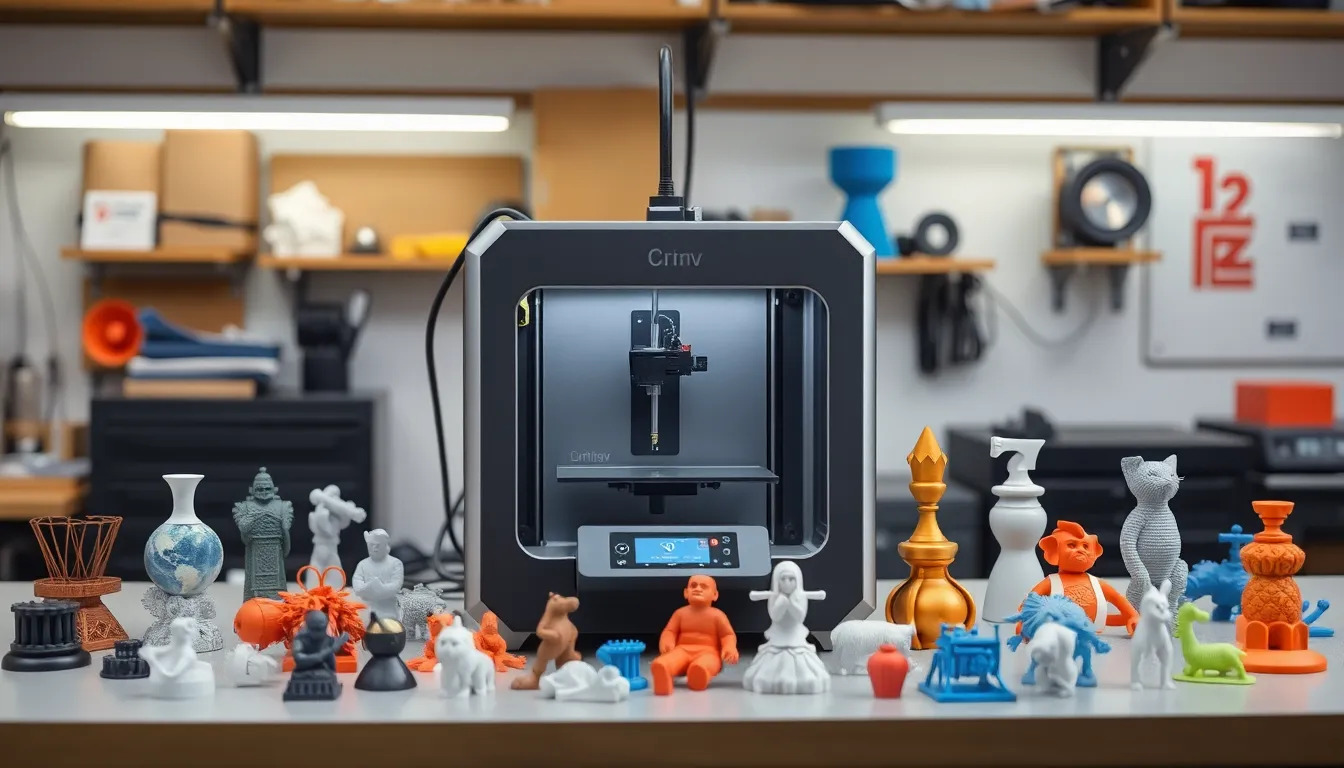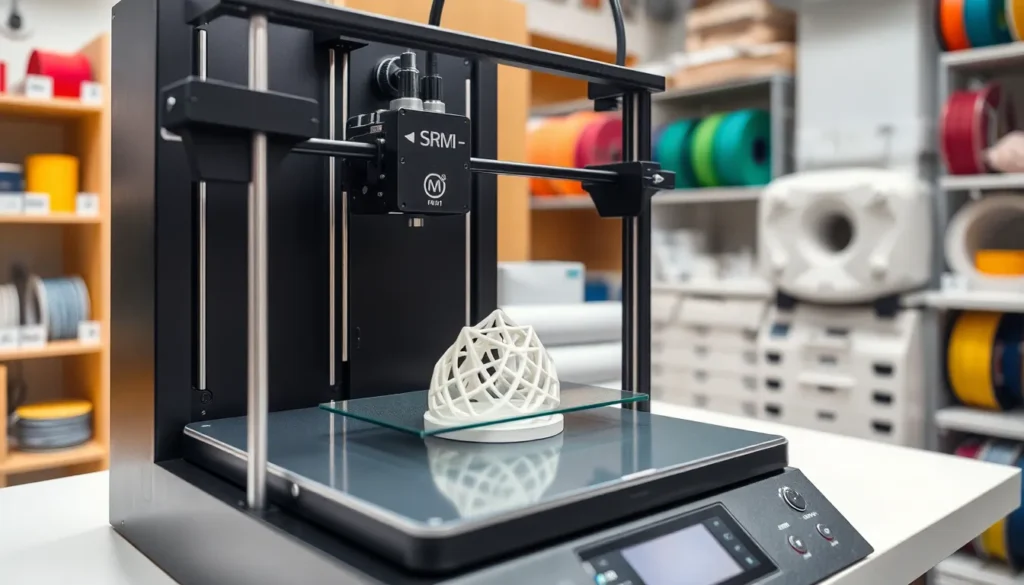When it comes to 3D printing, the question on everyone’s mind is: how much is this futuristic magic going to cost? Picture this: you’re ready to turn your wildest ideas into reality, but your wallet’s giving you the side-eye. Fear not! Understanding the costs involved can help you avoid a financial meltdown while still printing that life-sized dinosaur you’ve always wanted.
Table of Contents
ToggleOverview of 3D Printing Costs
3D printing costs vary based on several factors. Material types significantly influence expenses. For instance, PLA and ABS filaments typically range from $20 to $50 per kilogram. High-performance materials, like nylon or carbon fiber composites, can go as high as $200 per kilogram.
Printer quality also impacts overall pricing. Entry-level 3D printers may cost between $200 to $500, while professional-grade models can exceed $5,000. Maintenance and operational costs add another layer. Regular components, such as nozzles and build plates, require replacement, which impacts long-term expenses.
Service providers offer different pricing structures as well. Project complexity and size play a role in determining costs. Simple designs often come at lower prices, whereas intricate models may incur additional fees. Bulk printing also creates potential savings, with discounts typically provided for larger orders.
Energy consumption is another consideration. 3D printers consume about 0.1 to 0.5 kWh per hour, affecting electricity bills, especially during extensive projects. Some projects involve post-processing steps, including sanding or painting, which add expenses but improve final aesthetics.
Delivery times can vary, impacting costs for urgent projects. Rushed orders may yield higher rates, depending on the service provider. Understanding these facets allows for better budgeting and planning, ensuring projects remain financially viable.
Initial Investment

Initial investments in 3D printing can vary significantly based on multiple factors. Understanding these costs helps individuals budget effectively for their projects.
Printer Types and Pricing
Different types of printers cater to various needs and budgets. Entry-level models, often suitable for hobbyists, typically range from $200 to $500. Mid-range printers can cost between $500 and $1,500, offering enhanced features and print quality. High-end machines, ideal for professionals, usually exceed $5,000 and support advanced materials and larger build volumes. Specialty printers designed for unique applications, like resin printers, might also require an investment of $1,000 or more. Evaluating printer capabilities based on project requirements ensures optimal spending.
Software Expenses
Software requirements contribute to the overall cost of 3D printing. Many users opt for free software options such as Tinkercad or Blender for basic designs. Paid software packages, which grant advanced modeling capabilities, usually start at $100 and can reach several thousand dollars based on functionality. Subscription-based models promote ongoing updates and user support, typically costing between $30 and $200 monthly. Some printers come with proprietary software included, reducing initial costs. Choosing the right software directly impacts ease of use and project success.
Material Costs
Material costs play a critical role in the overall expense of 3D printing projects. Understanding these costs helps individuals budget effectively.
Filament Prices
Filament prices vary significantly based on material type and quality. Common options like PLA and ABS typically range from $20 to $50 per kilogram. Those seeking high-performance materials should anticipate prices reaching up to $200 per kilogram. Bulk purchases often lead to cost savings, making it economical for larger projects. Users frequently choose filament based on project requirements and desired finish, influencing total expenses.
Resin Costs
Resin costs generally fall within a higher price bracket compared to traditional filaments. Standard resin costs usually range from $30 to $150 per liter. Specialized resins, such as those for dental or engineering applications, may exceed $300 per liter. Budgeting for resin entails considering factors like print resolution and detail quality, which directly impact overall costs. Choosing the right resin significantly affects project outcomes and material expenditure.
Operational Costs
Understanding operational costs is crucial for anyone exploring 3D printing. These expenses significantly affect the overall budget for projects, especially larger and more complex ones.
Electricity Usage
Electricity usage plays a notable role in operational costs. Typical 3D printers consume between 50 and 250 watts during printing, with larger units potentially using more power. Projects that take multiple hours to complete increase energy expenditure. On average, printing a standard object consumes about $0.10 to $0.20 worth of electricity. Calculating energy costs involves the duration of print jobs and wattage of the printer, which can accumulate over time.
Maintenance and Repairs
Maintenance and repairs contribute to ongoing expenses as well. Regular upkeep is necessary to ensure optimal printer performance, costing approximately $100 to $300 annually. Wear and tear on components like print heads and build plates may prompt replacement, leading to additional costs. Keeping printers clean and calibrated can prevent significant malfunctions, which might require costly repairs. Budgeting for unexpected repairs helps manage financial strain throughout the printing process.
Cost Comparison
Cost comparison in 3D printing varies depending on the method used, whether home printing or professional services. Understanding this comparison helps individuals choose the best option for their projects.
Home vs. Professional Printing
Home printing expenses rely on multiple factors, including the type of printer and materials. Entry-level printers cost between $200 and $500, while mid-range models range from $500 to $1,500. Material prices also affect expenses; for instance, PLA and ABS filaments typically retail for $20 to $50 per kilogram. Professional printing, on the other hand, can exceed $5,000 for high-end machines. Costs for professional services include not just printer expenses but also labor and overhead, often making them more suitable for complex projects. While home printing offers cost-effective solutions for simpler tasks, professionals provide higher precision and quality for intricate designs.
On-Demand Services
On-demand printing services present another option, especially for those needing specialized projects. These services typically charge based on the complexity and size of the printed item. Pricing can vary significantly, with costs ranging from $50 for small prints to several hundred dollars for larger, detailed models. Using on-demand services eliminates the need for an initial investment in printers or materials. Customers can upload designs online, receive instant quotes, and have their items printed and shipped directly to them. This convenience appeals to many, particularly for short-run production and prototypes, providing flexibility that in-house setups may lack.
Understanding the costs associated with 3D printing is essential for anyone looking to embark on this creative journey. By considering factors like material choice printer quality and operational expenses individuals can budget effectively and avoid unexpected financial strain. Whether opting for home printing or professional services each route offers unique advantages that cater to different needs and project complexities.
With careful planning and an awareness of potential costs individuals can bring their ideas to life without breaking the bank. Embracing the world of 3D printing opens up endless possibilities for innovation and creativity making it a worthwhile investment for hobbyists and professionals alike.





